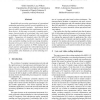Free Online Productivity Tools
i2Speak
i2Symbol
i2OCR
iTex2Img
iWeb2Print
iWeb2Shot
i2Type
iPdf2Split
iPdf2Merge
i2Bopomofo
i2Arabic
i2Style
i2Image
i2PDF
iLatex2Rtf
Sci2ools
ESTIMEDIA
2003
Springer
2003
Springer
Performance characterization of a low-cost video codec on portable devices
Bandwidth and processing requirements of conventional multimedia applications typically exceed capabilities of current technology portable terminals. Applications should hence be able to accommodate their requirements to run on these devices. In this paper we provide a complete performance characterization of a prototypal video codec based on techniques which trade-off complexity with reproduction quality. Comparison with standard codecs like H263 and MPEG-4 demonstrates a remarkable reduction of coding times, potentially enabling real-time processing of multimedia data on low-power devices. However, these performance gains are achieved at expenses of PNSR, making the approach suited to applications like videoconferencing only if a limited quality is acceptable. Our analysis also points out and quantifies some limitations of current technology lowpower devices.
Conventional Multimedia Applications | Current Technology | ESTIMEDIA 2003 | Technology Portable Terminals |
| Added | 06 Jul 2010 |
| Updated | 06 Jul 2010 |
| Type | Conference |
| Year | 2003 |
| Where | ESTIMEDIA |
| Authors | Giulio Iannello, Luca Vollero, Francesco Delfino |
Comments (0)

